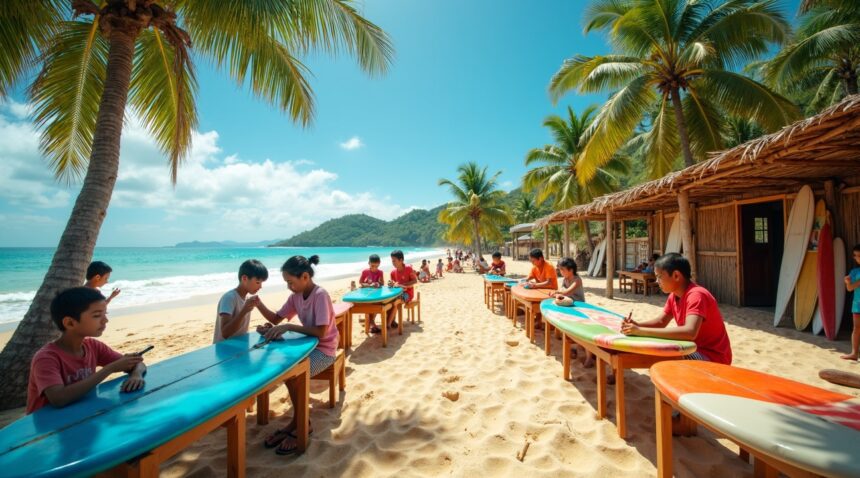Philippines surf communities have pioneered an innovative solution that converts broken surfboards into functional school desks, addressing both environmental waste and critical classroom furniture shortages across island regions.
Since 2008, these community-driven initiatives have successfully transformed over 50 discarded surfboards into educational furniture while helping more than 80 children complete their schooling.
Key Takeaways
- Environmental and Educational Impact: The program prevents surfboard waste from entering landfills while providing durable classroom furniture that withstands the Philippines’ harsh coastal climate conditions better than traditional wooden desks.
- Community Collaboration: Success depends on partnerships between surf shops, local craftspeople, schools, and volunteers who work together to collect damaged boards and convert them into customized educational furniture.
- Student Engagement: Schools report improved attendance rates and academic performance, with 15 students earning honors since the program began, as the unique surfboard desks create excitement about attending school.
- Typhoon Resilience: Surfboard desks demonstrate superior durability during severe weather events, with schools reporting that converted furniture survived storms that destroyed traditional wooden pieces.
- Scalable Model: The donor-supported, mobile framework has expanded beyond initial locations in Siargao and Mindanao, with other coastal communities adapting the model to address their own educational infrastructure challenges.
To learn more about one of these remarkable surf communities, visit the official site for Surfboards to School Desks Initiative.
From Waves to Classrooms: How Broken Surfboards Are Solving Education Furniture Shortages
I’ve witnessed an incredible transformation taking place across Philippine islands where discarded surfboards find new purpose in educational settings. Surf clubs and community organizations on Siargao and Mindanao have pioneered innovative projects that convert broken surfboards into functional school desks, creating solutions for both environmental waste and classroom furniture shortages.
These surfboard upcycling initiatives began gaining momentum in 2008, when local communities recognized the dual opportunity to reduce waste while addressing educational needs. Since then, volunteers have successfully repurposed over 50 surfboards, transforming them from ocean debris into valuable classroom furniture. The process involves skilled volunteers who repair damaged boards and expertly convert them into sturdy desks and tables suitable for student use.
Community-Driven Solutions Creating Lasting Impact
The success of these programs stems from strong collaboration between surf communities and local educational institutions. Community organizations coordinate with schools to identify specific furniture needs, ensuring each converted surfboard serves a practical purpose. Volunteers work directly with school administrators to customize desk designs based on student age groups and classroom requirements.
Voluntourism trips have become instrumental in expanding these sustainability efforts throughout the region. International visitors participate in hands-on conversion workshops, learning traditional craftsmanship techniques while contributing to local education infrastructure. These programs create meaningful connections between visitors and communities while providing essential volunteer labor for the conversion process.
Local youth play a central role in these initiatives, learning both surfing skills and woodworking craftsmanship. Young participants gain valuable technical skills while understanding environmental stewardship principles, which encourages their continued school participation. Many students develop pride in using desks crafted from materials that once rode Philippine waves.
The environmental impact extends beyond simple waste reduction. Each repurposed surfboard prevents potential ocean pollution while reducing demand for new furniture materials. Schools receive durable, unique desks that serve educational needs while telling stories of community innovation and environmental responsibility.
Surf clubs coordinate collection efforts across coastal areas, identifying damaged boards that would otherwise become waste. These organizations maintain networks of skilled craftspeople who volunteer their time to ensure quality conversions. The collaborative approach has inspired similar initiatives on other Philippine islands, demonstrating the scalability of this creative solution.
The program addresses critical furniture shortages that affect many Philippine schools, particularly in remote island communities. Students who previously struggled with inadequate seating now benefit from sturdy, properly sized desks that enhance their learning environment. This creative approach to Philippine environmental initiatives demonstrates how local innovation can address multiple community challenges simultaneously.
Each converted surfboard represents a victory against both educational barriers and environmental waste, proving that creative thinking can transform discarded materials into valuable community resources.
Transforming Student Lives: Measurable Impact Since 2008
The remarkable success of surfboard-to-desk conversion programs in the Philippines demonstrates how innovative recycling can create lasting educational change. Since 2008, these initiatives have helped over 80 children complete their schooling, with 15 students earning honors during their academic journey. This impressive track record highlights the tangible benefits that sustainable furniture solutions bring to underserved communities.
Durability stands as one of the most significant advantages of these repurposed surfboards. The acrylic material used in surfboard construction offers exceptional resilience against the Philippines’ challenging climate conditions. Traditional wooden desks often deteriorate quickly in coastal areas where typhoons and humidity create harsh environments for educational infrastructure. Surfboard desks withstand these conditions far better, providing students with stable learning surfaces that don’t require frequent replacement.
Student retention rates have improved significantly in schools that have adopted these recycled desks. The unique furniture creates excitement about attending school, transforming what might otherwise be monotonous classrooms into engaging spaces. Children take pride in using desks made from materials once enjoyed by surfers, creating positive associations with their learning environment.
Building Stronger Communities Through Collaboration
Community engagement has flourished through the partnerships that make these projects possible. Local surf organizations, school administrators, teachers, and sponsors work together to identify schools in need and coordinate desk installations. These collaborations strengthen existing relationships while fostering new connections between previously disconnected groups.
The process involves several key participants who contribute different resources and expertise:
- Surf shops and manufacturers donate damaged or retired surfboards
- Local craftspeople handle the conversion process, creating employment opportunities
- School staff coordinates installation and maintenance schedules
- Community sponsors provide funding for tools and additional materials
- Students and parents participate in awareness campaigns about environmental conservation
Environmental awareness grows naturally through these initiatives. Students learn firsthand how waste materials can become valuable resources when creativity meets determination. This hands-on experience with recycling principles encourages young people to think differently about consumption and disposal practices. Many students report increased interest in environmental science topics after using surfboard desks in their classrooms.
The typhoon resilience of these desks has proven invaluable in a country frequently affected by severe weather events. Schools in coastal provinces particularly benefit from furniture that can withstand flooding and high winds. After Typhoon Haiyan devastated parts of the Philippines, several schools with surfboard desks reported that their furniture survived while traditional wooden pieces were destroyed. This resilience means fewer disruptions to education and reduced replacement costs for cash-strapped institutions.
Academic incentives emerge naturally from these unique learning environments. Teachers notice that students show greater enthusiasm for attending school when they have interesting, durable desks. The novelty factor initially attracts attention, but the improved comfort and functionality maintain engagement over time. Students develop ownership feelings for their special desks, leading to better care of school property overall.
Partnership success stories continue to multiply across different regions. In Siargao, local surf schools have established ongoing relationships with elementary schools, creating sustainable pipelines for desk donations. Similar programs in La Union and Baler have expanded to include other recycled surfboard products like benches and storage units.
The ripple effects extend beyond immediate educational benefits. Families report increased interest in their children’s schooling when unique elements like surfboard desks capture community attention. Parents become more involved in school activities, and local businesses often step forward with additional support once they see successful projects in action.
These transformative programs demonstrate how simple innovations can address multiple challenges simultaneously. By converting waste into educational resources, communities solve disposal problems while improving learning conditions. The success of various community initiatives in the Philippines shows how creative problem-solving can generate lasting positive change.
Current expansion plans aim to reach additional provinces where surfing communities exist alongside schools needing furniture upgrades. The proven model offers a replicable solution that other coastal nations could adapt to their specific circumstances and available resources.
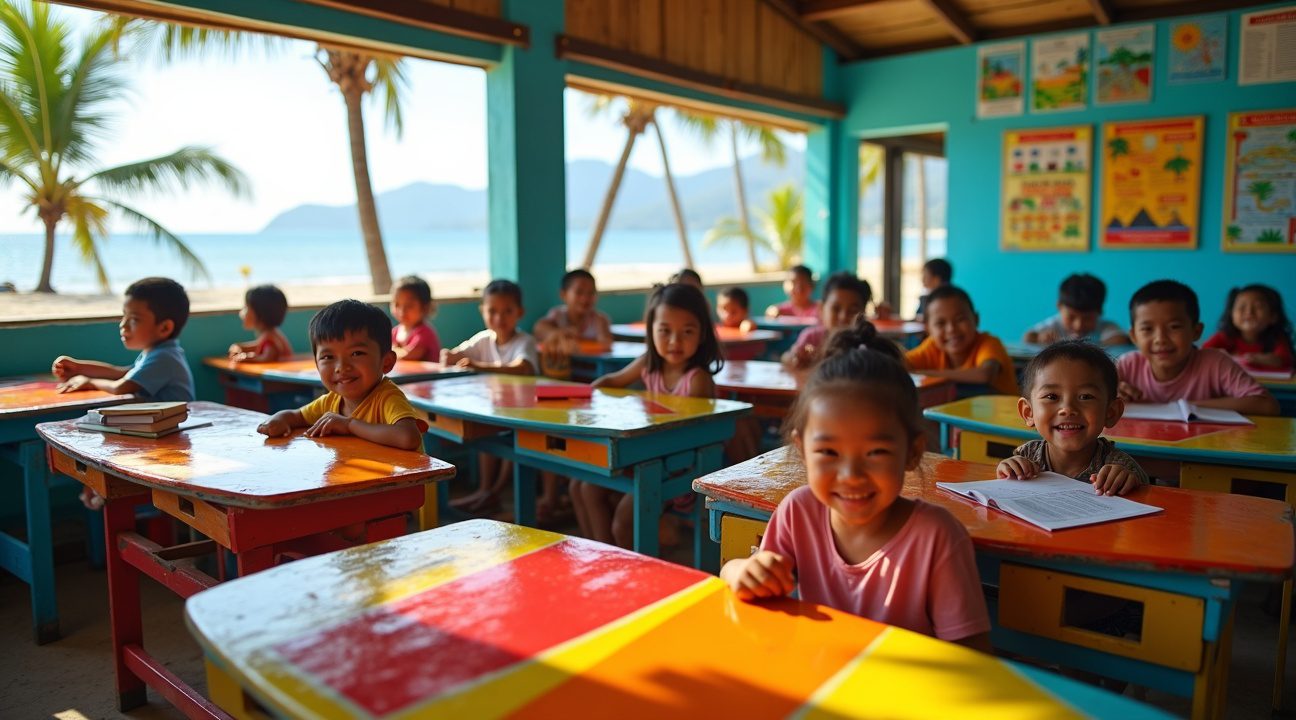
The Scale of Philippines Education Infrastructure Crisis
The Philippines confronts a staggering education infrastructure crisis that affects millions of students across the archipelago. According to the Department of Education (DepEd), the country needed 110,954 new classrooms as of 2021, revealing the massive scope of educational facility shortages that plague the nation’s learning institutions.
Overwhelming Classroom Deficits
Annual enrollment growth consistently adds pressure to an already strained system. With enrollment increases of 1.5% to 2% each year, approximately 10,000 additional classrooms become necessary annually just to accommodate new students. This continuous demand creates a perpetual cycle where construction efforts struggle to keep pace with educational needs.
The situation becomes even more critical when examining existing infrastructure conditions. More than 28,500 school buildings have been condemned or await condemnation, requiring the replacement of 85,524 classrooms. These structures pose safety risks to students and teachers while hampering effective learning environments that children deserve.
Beyond Buildings: The Furniture Crisis
Classroom shortages represent only part of the challenge facing Philippine education. School desk deficiencies and furniture shortages create additional barriers to effective learning experiences. Natural disasters frequently compound these problems by damaging existing infrastructure and destroying essential classroom equipment.
Educational officials consistently identify inadequate school furniture as a significant obstacle preventing optimal learning conditions. Students often share desks, sit on floors, or use makeshift surfaces for their schoolwork. These conditions directly impact concentration, posture, and academic performance across rural and urban schools alike.
The convergence of condemned school buildings, insufficient new construction, and furniture shortages creates a perfect storm that affects educational quality nationwide. While innovative solutions like environmental conservation efforts capture public attention, education infrastructure remains a pressing concern requiring immediate action.
Climate-related disasters add another layer of complexity to this crisis. Typhoons, earthquakes, and flooding regularly destroy newly built facilities and furniture, setting back progress made through government and private initiatives. Recovery efforts must then compete with ongoing expansion needs, stretching limited resources even thinner.
The education infrastructure crisis demands comprehensive solutions that address both immediate needs and long-term sustainability. Creative approaches to sourcing materials and funding become essential as traditional methods fall short of meeting the overwhelming demand for safe, functional learning spaces equipped with proper furniture and educational tools.
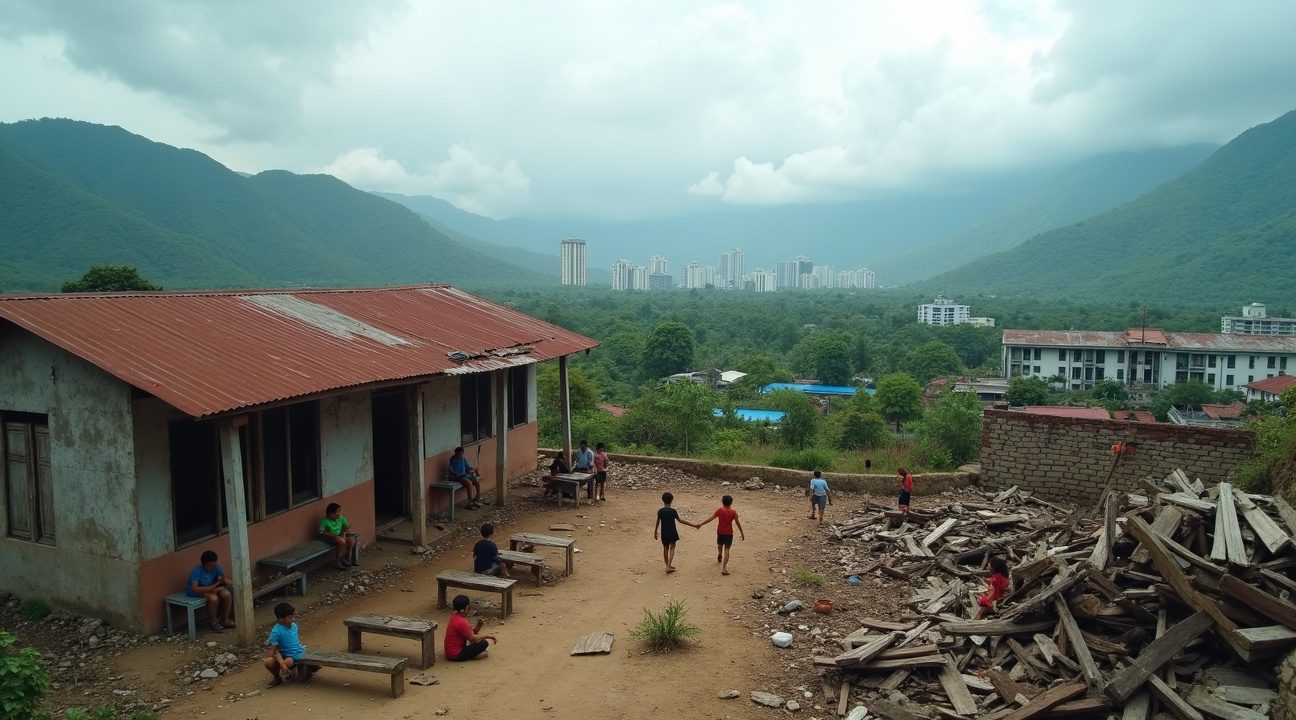
Classroom Overcrowding: From Crisis to Gradual Improvement
I’ve witnessed firsthand how overcrowded classrooms have long plagued Philippine education, creating an environment where effective learning becomes nearly impossible. The situation reached critical levels during the early 2000s, when students were packed into spaces that couldn’t adequately support quality education.
The Numbers Tell a Stark Story
During the 2002-2003 academic year, elementary classrooms averaged over 40 pupils each, while secondary rooms accommodated more than 55 students. These cramped conditions made it difficult for teachers to provide individual attention and for students to focus on their studies. Fast-forward to 2019-2020, and I can see significant progress in student-to-classroom ratios. Elementary classes dropped to 29 students, junior high classes to 39 students, and senior high maintained 31 students per classroom.
While these improvements represent substantial progress, challenges persist across the archipelago. Infrastructure developments haven’t kept pace with population growth, creating an ongoing infrastructure gap that affects educational quality. Natural disasters compound this problem, destroying existing facilities and requiring extensive disaster recovery efforts that strain already limited resources.
The environmental challenges the Philippines faces mirror the educational infrastructure struggles, as both require sustained commitment and innovative solutions. DepEd’s 2030 projections highlight that simply building new classrooms won’t solve the problem entirely. According to these forecasts, improvements must extend beyond construction to include retrofitting existing structures and providing essential furniture and ICT resources.
This comprehensive approach recognizes that modern education requires more than just physical space. Students need proper desks, chairs, and technology access to compete in today’s digital landscape. The shortage of basic furniture remains particularly acute in rural areas, where schools often lack sufficient seating and work surfaces for students.
Creative solutions have emerged from this necessity, including community-driven initiatives that repurpose materials for educational use. These grassroots efforts demonstrate Filipino ingenuity in addressing resource constraints. Local communities have stepped up to bridge gaps in government funding, much like how lottery winners sometimes contribute to educational causes.
The retrofitting component of DepEd’s strategy focuses on upgrading older buildings to meet current safety and capacity standards. Many existing structures were built decades ago and lack proper ventilation, lighting, and accessibility features. Modernizing these facilities costs less than new construction while maximizing the use of existing resources.
ICT resource provision represents another critical element of infrastructure development. Digital literacy has become essential for students to succeed in higher education and the job market. Schools need reliable internet connections, computers, and multimedia equipment to prepare students for 21st-century challenges.
Population growth continues to outpace infrastructure development in many regions, particularly in urban areas experiencing rapid migration from rural provinces. Metro Manila and other major cities face the greatest pressure to expand educational facilities quickly. Provincial areas, while having lower population density, often struggle with geographical isolation that makes resource delivery challenging.
Disaster recovery needs add another layer of complexity to infrastructure planning. Typhoons, earthquakes, and flooding regularly damage school buildings, requiring emergency repairs and sometimes complete reconstruction. Building resilient structures that can withstand natural disasters costs more initially but proves more economical long-term.
The success stories from recent years show that sustained effort yields results. Schools that received comprehensive upgrades report improved attendance rates and better academic performance. Teachers working in properly equipped classrooms can implement more engaging teaching methods and provide individualized support to struggling students.
Private sector partnerships have become increasingly important in addressing infrastructure gaps. Companies contribute funding, materials, and expertise to school improvement projects. These collaborations often focus on specific needs like computer labs, libraries, or playground equipment that enhance the learning environment beyond basic classroom space.
Looking Ahead
Maintaining momentum in infrastructure development requires continued political will and resource allocation. The progress made since the early 2000s demonstrates that persistent effort can transform educational conditions, but sustaining these improvements demands ongoing commitment from all stakeholders.
Surf Culture Meets Educational Innovation in Island Communities
The Philippines’ surf hotspots aren’t just producing world-class waves anymore – they’re creating innovative solutions to educational challenges. In regions like Siargao and Mindanao, where vibrant surf cultures thrive alongside persistent educational infrastructure gaps, local communities have discovered an unexpected resource for addressing critical shortages in classrooms and school furniture.
These island communities face significant obstacles in providing adequate learning environments for their children. Schools often lack basic furniture, with students sitting on floors or sharing makeshift seating arrangements that hinder their ability to focus and learn effectively. The shortage of proper desks and chairs affects thousands of students across these surf-centric regions, where tourism brings economic benefits but educational infrastructure frequently lags behind development.
From Broken Boards to Learning Stations
The surfboard-to-desk initiative transforms damaged and discarded surfboards into functional school furniture, creating a perfect intersection between local surf culture and educational innovation. This creative approach addresses two problems simultaneously: reducing waste from the surf industry while providing essential furniture for under-resourced schools.
Local craftspeople work with volunteers and community members to convert broken boards into sturdy desks and benches. The process involves careful planning to ensure the furniture meets educational needs while maintaining durability for daily classroom use. Each transformed surfboard carries the spirit of the waves into the classroom, creating unique learning environments that reflect the community’s identity.
Scaling Success Through Strategic Partnerships
The mobile and donor-supported model behind this initiative has attracted attention from educators and development organizations across multiple regions. Its success demonstrates how community-driven solutions can achieve remarkable results when supported by effective partnerships among local governments, NGOs, and private donors.
Key elements contributing to the program’s effectiveness include:
- Direct community involvement in identifying needs and participating in furniture creation
- Collaboration between surf shops, local artisans, and educational institutions
- Support from tourism businesses that benefit from positive community impact
- Engagement of visiting surfers and tourists as volunteers and donors
- Integration with existing educational programs and curriculum development
The initiative’s replicable nature has sparked interest from other coastal communities facing similar challenges. Educational advocates see potential for adaptation in regions beyond the Philippines, particularly in developing countries where surf culture intersects with educational infrastructure gaps.
Public-private partnerships have proven essential to the program’s sustainability. Local governments provide logistical support and help identify priority schools, while private donors contribute funding for materials and transportation. NGOs facilitate coordination between stakeholders and ensure proper implementation of safety standards for the converted furniture.
The community model emphasizes local ownership and participation rather than external dependency. Residents learn skills in furniture conversion and repair, creating long-term capacity for maintaining and expanding the program. This approach builds social cohesion while addressing practical educational needs.
Success stories from pilot implementations have encouraged expansion into additional island communities. Schools report improved attendance and engagement when students have proper seating arrangements, while communities take pride in their innovative solution to educational challenges. The initiative has also strengthened connections between the surf tourism industry and local education systems.
Similar to how conservation efforts can transform local communities, this educational innovation demonstrates the power of creative thinking in addressing social challenges. The program continues expanding its reach, with plans to develop standardized conversion processes and training materials for new communities interested in implementation.
The surfboard-to-desk transformation represents more than furniture creation – it symbolizes how communities can leverage their unique cultural assets to solve pressing social problems. Through strategic partnerships and community engagement, this initiative proves that innovative solutions often emerge from unexpected sources, turning what might be considered waste into valuable educational resources that serve future generations.
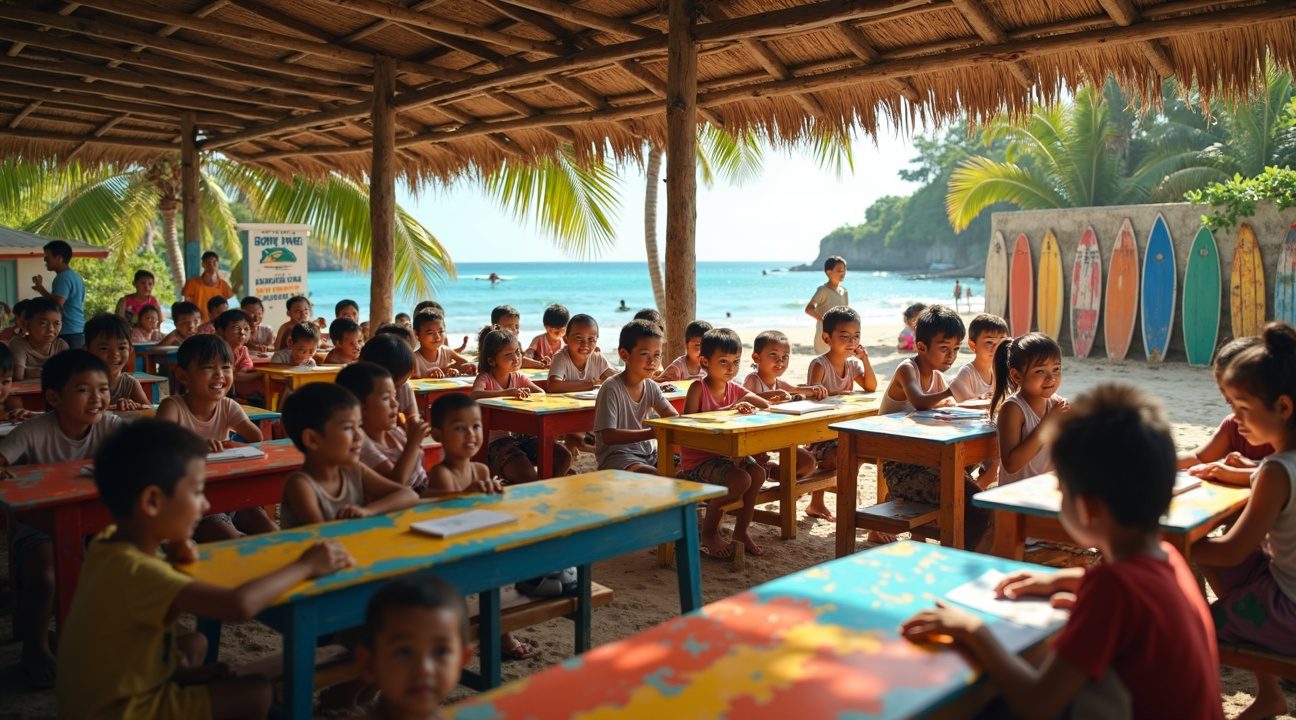
Expanding the Model: Replication and Future Growth
The transformation of damaged surfboards into educational furniture creates significant environmental benefits that extend far beyond individual classrooms. I’ve observed how this innovative approach prevents countless boards from ending up in landfills, where they would decompose slowly due to their fiberglass and foam construction. Each repurposed surfboard represents a meaningful reduction in waste while simultaneously addressing critical educational infrastructure needs.
Growing Donation Networks and Community Participation
Expansion efforts focus heavily on building stronger donation networks across coastal communities. I see organizations actively reaching out to surf shops, beach resorts, and individual surfers to collect old surfboards, skimboards, and bodyboards that would otherwise be discarded. The response has been overwhelmingly positive, with many donors expressing enthusiasm about giving their old equipment a second life in educational settings.
The donation process remains simple and accessible, encouraging widespread participation from diverse community members. Surf shops report increased customer engagement when they promote the program, while beach communities develop stronger connections to local schools through these contributions. This grassroots approach ensures steady material supply while fostering deeper relationships between different sectors of society.
Scaling the Community-Driven Model
The mobile, donor-driven framework proves highly adaptable for different geographic and economic contexts. I notice how this flexibility makes replication feasible across various regions within the Philippines, from urban coastal areas to remote island communities. The model doesn’t require large-scale industrial infrastructure, making it particularly suitable for developing areas with limited resources.
Schools in other provinces have begun implementing similar programs, adapting the basic concept to their specific needs and available materials. Some institutions combine surfboard furniture with other upcycling projects, creating comprehensive sustainability programs that engage students directly in environmental stewardship. The educational value extends beyond simply providing furniture – students learn about recycling, community cooperation, and creative problem-solving.
International attention has grown as well, with similar initiatives gaining recognition in other coastal nations facing comparable challenges. Educational administrators from countries with surfing cultures express interest in adapting this model to their own contexts, recognizing both the practical benefits and the positive community engagement it generates.
The sustainability aspect resonates strongly with younger generations who prioritize environmental responsibility. Schools report increased student pride and ownership over their learning spaces when they understand the furniture’s origin story. This emotional connection enhances the overall educational environment while reinforcing important lessons about resource conservation and creative thinking.
Success metrics continue to improve as the program expands:
- More schools report enhanced learning conditions
- Increased student attendance
- Stronger community support
The cost-effectiveness of this approach particularly appeals to educational administrators working with tight budgets, as it provides quality furniture at minimal expense while supporting environmental goals.
Community involvement remains the cornerstone of successful expansion. I see how local partnerships between schools, businesses, and environmental groups create sustainable support networks that ensure long-term program viability. These relationships often develop into broader collaborations that benefit communities in multiple ways, from educational initiatives to environmental conservation projects.
The model’s growth potential appears substantial, especially in regions where traditional furniture procurement faces significant challenges. Success stories from initial implementations provide powerful examples for other communities considering similar programs.
Future expansion plans include:
- Developing standardized processes that maintain quality while allowing for local customization
- Training programs for craftspeople and volunteers to ensure consistent results
- Documentation of best practices to facilitate knowledge transfer between communities
The initiative demonstrates how creative approaches to waste reduction can address multiple societal needs simultaneously. Environmental protection combines with educational support while strengthening community bonds, creating a model that delivers benefits across various sectors. This multi-faceted impact makes the program particularly attractive for replication in diverse settings where similar challenges exist.
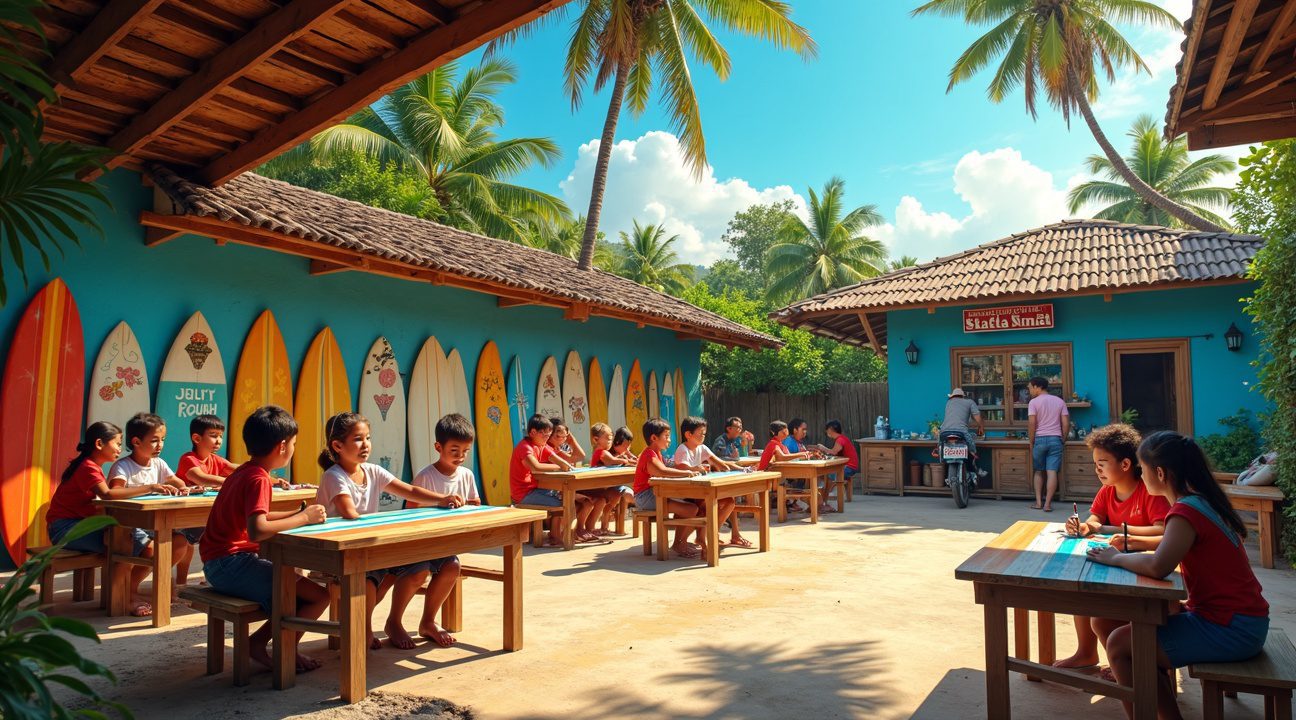
Sources:
Department of Education (DepEd)

